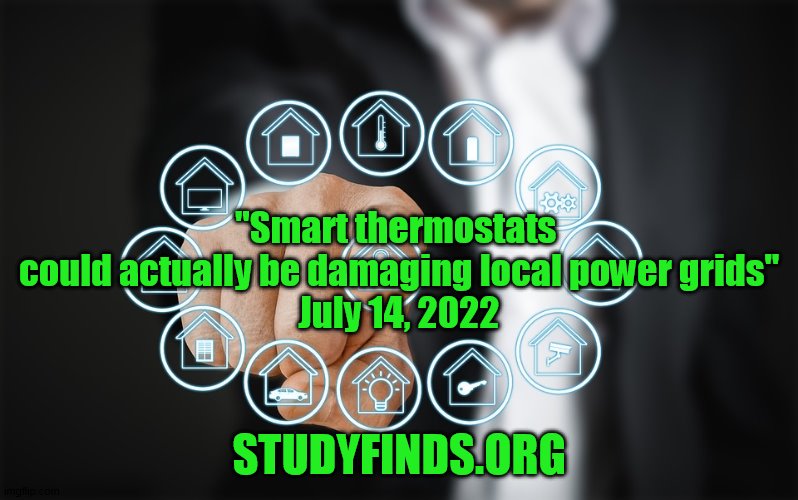 By B.N. Frank
By B.N. Frank
Utility companies, regulators, and various experts continue to warn that American power grids are vulnerable and prone to blackouts (see 1, 2, 3, 4). This has led to a growing number of utilities and organizations encouraging customers to install smart thermostats which allow utilities to remotely control customer energy use.
In June of 2021, smart thermostats being remotely controlled by a Texas utility led to dangerously hot temperatures in customers’ homes. More recently a study revealed that smart thermostats could actually be damaging local power grids.
Nevertheless, American utility companies are likely to continue encouraging customers to install smart thermostats so they can remotely control their energy use. A Wisconsin utility is even paying customers to install them.
From Madison.com:
Alliant Energy to pay customers $25 to take over their thermostats at peak times
Chris Hubbuch | Wisconsin State Journal
Alliant Energy has launched a suite of programs to help balance the grid by adjusting customer thermostats.
Alliant Energy is looking to its customers for help keeping the electrical grid in balance.
The Madison-based utility is rolling out a suite of programs to offer cash rewards in exchange for giving up occasional control over thermostats and water heaters.
Under one new program, customers with internet-connected thermostats can receive $25 a year for allowing the utility to adjust the temperature in their homes by a few degrees up to 20 times per year, typically on hot summer afternoons when electricity use peaks.
According to regulatory filings, Alliant aims to enroll up to 7,000 households over the next two years, which the company says could provide up to 5 megawatts of capacity that could be called on instead of generators.
The utility says it may also use it to manage gas flows during winter months when utilities’ growing reliance on gas to generate electricity competes with home heating needs.
“Smart thermostats give customers more control over their energy use and make it easier than ever to reduce their energy bills,” said Kari Gehrke, Alliant’s manager of demand management. “Our Smart Hours program allows customers to personalize their temperature preferences and increase the flexibility of their heating and cooling systems.”
Customers can opt out of individual events (by simply re-adjusting their thermostats), but they can only do so three times a year and still receive the $25 incentive.
Those without eligible thermostats can get a $50 discount through the state’s energy efficiency program. Alliant says installing a smart or programmable thermostat can cut energy bills by about 10%.
The company has developed a similar program for internet-enabled electric water heaters and is testing the concept with a pair of refrigerated warehouses.
Altogether, Alliant expects the Smart Hours program will cost ratepayers about $1.4 million a year, including incentives and administrative costs.
Such demand management programs can offset the need for additional generation, storage and distribution equipment, lowering overall costs and avoiding the pollution produced by burning fossil fuels.
A 2020 report by M-WERC, a nonprofit group focused on economic development for Wisconsin’s energy, power and controls sector, identified thermostat control programs as one of the most cost-effective ways utilities could rescue emissions while creating jobs.
Other utilities, including Madison Gas and Electric and Xcel Energy, offer similar thermostat programs, though Alliant would be the first to use it to manage gas usage.
Statewide about 100,000 customers are enrolled in some type of demand management program, providing about 6% to 7% of the state’s historic peak demand, according to the Public Service Commission. But less than half of that capacity was actually dispatched over the past four years, primarily because most are used only in emergencies.
That could change under a recent order by the Federal Energy Regulatory Commission, which will allow a utility or other company to aggregate demand response capacity into a single resource that can participate in wholesale power markets. However, the Midwest grid operator, MISO, does not plan to implement that policy until 2030.
Demand management programs can offset the need for additional generation, storage and distribution equipment, lowering overall costs and avoiding the pollution produced by burning fossil fuels.
Other issues associated with “Smart Thermostats” include
- they can be hacked
- they are privacy invasive
- they emit high levels of biologically and environmentally harmful electromagnetic radiation which can also affect pets
Activist Post reports regularly about smart appliances and other unsafe technology. For more information, visit our archives and the following websites:
- Electromagnetic Radiation Safety
- Environmental Health Trust
- Physicians for Safe Technology
- Wireless Information Network
Become a Patron!
Or support us at SubscribeStar
Donate cryptocurrency HERE
Subscribe to Activist Post for truth, peace, and freedom news. Follow us on SoMee, Telegram, HIVE, Flote, Minds, MeWe, Twitter, Gab, What Really Happened and GETTR.
Provide, Protect and Profit from what’s coming! Get a free issue of Counter Markets today.

Be the first to comment on "Utility Offers to Pay Customers to Install Smart Thermostats to Allow It to Remotely Control Energy Use"